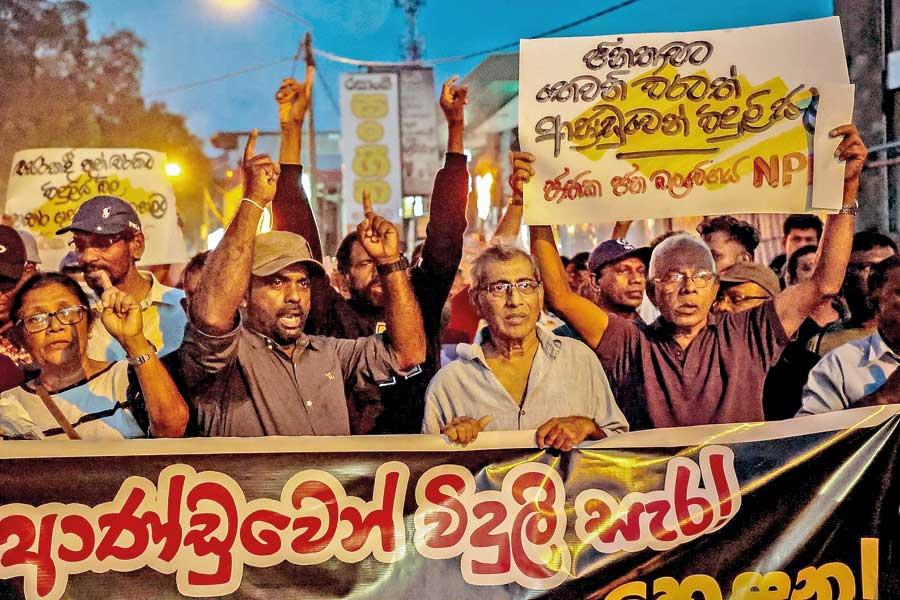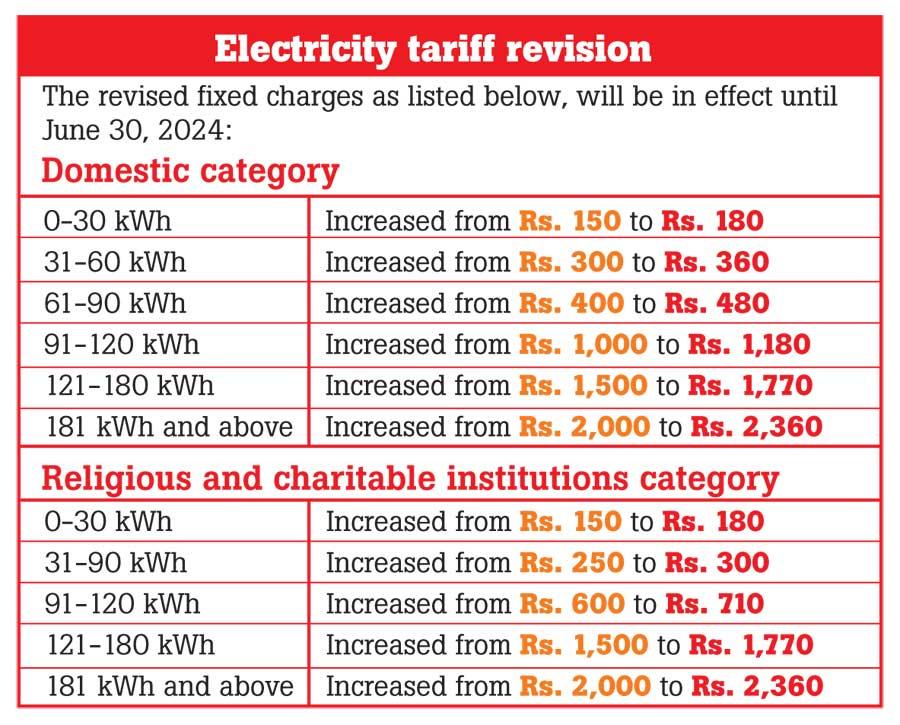27 Oct 2023 - {{hitsCtrl.values.hits}}

Protests organized by National People Power against the latest electricity tariff hike were held across the country over the past few days
At least one hundred thousand electricity consumers in Sri Lanka have been left in the dark over the past one year as they have been unable to pay the accumulated electricity bills by the expected deadline. Sri Lanka witnessed a 70% increase in electricity tariffs over the past one year and consumers have been shocked to receive red notices which were to be addressed within 40 days. In this backdrop Sri Lanka witnessed its third electricity tariff revision for 2023 on October 21, this time a whopping 18%. This is in addition to a 66% increase in electricity tariffs implemented since February 15 and a 14% increase implemented since July 1, 2023.
expected deadline. Sri Lanka witnessed a 70% increase in electricity tariffs over the past one year and consumers have been shocked to receive red notices which were to be addressed within 40 days. In this backdrop Sri Lanka witnessed its third electricity tariff revision for 2023 on October 21, this time a whopping 18%. This is in addition to a 66% increase in electricity tariffs implemented since February 15 and a 14% increase implemented since July 1, 2023.
Sri Lanka witnessed its third electricity tariff revision for 2023 on October 21, this time a whopping 18%
Manipulation of figures?
One of the reasons for the recent electricity tariff hike as mentioned by the Ceylon Electricity Board (CEB) is to cover up for the losses incurred by this institution. But, energy experts and consumer rights activists claim that the figures have been largely manipulated. “By the end of August this year, the CEB claimed that it had incurred a Rs. 54 billion loss and submitted a letter to the cabinet requesting for a tariff hike,” said Electricity Users’ Association National Secretary Sanjeewa Dhammika. “When there was no response they slowly brought the figure down to Rs. 31 billion. From that it came down to Rs. 21 billion and finally to Rs. 18 billion,” said Dhammika.
In order to implement an electricity tariff hike, many aspects need to be taken into consideration. This includes the income generated by coal, hydropower, wind, diesel and renewable energy plants, the weather conditions etc. “On October 15, the Public Utilities Commission put forward this proposed tariff hike and requested stakeholders to provide their recommendations within three days. This is practically impossible and illegal in the first place. Once the cabinet paper was approved, an additional general manager at the CEB said that they can increase electricity tariffs on four instances in case of an emergency situation. But as far as I know, an emergency situation arises only if there has been a 25% difference in power generation compared to the estimated figure,” Dhammika further explained.
“Countries such as Bangladesh have profitable electricity boards where they charge electricity at half the price compared to Sri Lanka,”
- Dr. Tilak Siyambalapitiya Energy Specialist
Four illogical reasons presented by the CEB includes errant figures in terms of electricity consumption; a claim that there will be less hydropower generated due to the dry season and that it would only generate 430 GwH. “This is a false claim because hydropower generates more than 700 GwH of electricity as of today. A kilo of coal is purchased at Rs. 97 whereas the actual price is Rs. 52.90. The fourth reason is that the CEB is a loss-making institution. This too is a false claim,” he said.
He further claimed that all segments in society were not represented at the PUCSL’s public consultation which was held at the BMICH recently. “People in the estate communities and the North and East were not present. They in fact have information from all nine provinces and it is surprising to see them taking decisions overnight. We sometimes wonder how the public service has become this efficient all of a sudden,” Dhammika exclaimed.
When inquired if legal action would be taken regarding this decision Dhammika responded in the affirmative and added that legal action could be filed based on clause 119 of the Financial Regulations Act.
A kilo of coal is purchased at Rs. 97 whereas the actual price is Rs. 52.90
Consumers in a dilemma
The minimum monthly wage of a Sri Lankan is expected to be Rs. 12,500. In this backdrop, consumers are challenged with having to pay electricity bills, double or triple the value of their monthly income. Many have failed to pay bills issued with red notices which indicate that the total bill has to be settled within 40 days. In response a spate of protests were staged across the country in areas such as Kadawata, Debarawewa, Hemmathagama and Galle. “The people’s income has remained stagnant, but the electricity tariff has increased exponentially,” said National Movement for Consumer Rights Protection President Ranjith Vithanage. “As such people are unable to pay increased electricity bills. In addition to paying off utilities they have to pay school fees, rent and bear other expenses. We request from CEB and PUCSL to extend deadlines issued with regard to red notices and to make arrangements for people to pay off their accumulated bills in installments,” said Vithanage.
Vithanage further said that few academics have proposed impractical solutions such as switching off lights during peak hours. “How can we ask our children to limit their study time? If supermarkets and shops switch off their deep freezers the food that has been stored in them will be contaminated. Will CEB and PUCSL cover up these losses? In fact, the electricity tariff hike will take a toll on products and services and as a result the price of goods will continue to soar,” he warned.
Energy experts and consumer rights activists claim that the figures have been largely manipulated
Sustainable alternatives ignored?
Energy experts suspect whether Sri Lanka would beat Singapore in the near future when one considers the recent electricity tariff hike. “Sri Lanka was third in Asia for paying a high electricity tariff and the difference between us and Singapore was around 20%,” said international Energy Specialist Dr. Tilak Siyambalapitiya. “Countries such as Bangladesh have profitable electricity boards where they charge electricity at half the price compared to Sri Lanka.”
The electricity business has a fixed and a variable cost. “For example, investment, interest, salaries and maintenance are fixed costs, whereas the fuel costs and renewable energy purchase costs are variable. In the electricity business there are three main components; generation, transmission and distribution.
All three components have fixed costs. Only generation has variable costs. According to data submitted by Ceylon Electricity Board to Public Utilities Commission, the fixed cost of electricity generation is Rs. 3.92/unit of electricity. This is in the correct range when compared to other countries. The transmission cost is Rs. 1.62/unit and this too is in the correct range. The distribution cost is Rs. 4.59/ unit and it is once again in the correct range when compared to countries such as India, Indonesia and Bangladesh. Therefore, there are three fixed costs which are in the correct range,” Dr. Siyambalapitiya explained. So, savings in field costs are possible, but such savings will be small.
“We request from CEB and PUCSL to extend deadlines issued with regard to red notices and to make arrangements for people to pay off their accumulated bills in installments”
- Ranjith Vithanage National Movement for Consumer Rights Protection President
The Public Utilities Commission, the economic, commercial, technical and safety regulator of the electricity industry in Sri Lanka has come under much scrutiny over the recent few years in its role in regulating electricity tariffs. “For 10 years from 2013-2023, the PUCSL didn’t give a price increase to the CEB. Therefore, the CEB had to borrow heavily on short-term loans and these have to be repaid. This cost is added to the fixed costs Rs. 3.61. Now that costs and price are equal, no new short-term loans are required and this figure of 3.61 needs to come down to zero in a few years and the people must be told now, when this figure will be zero.
“So, the fixed costs are inevitable, but smaller savings are possible. Then there are variable costs of generation. The production cost for large hydro electric power plants is zero. But their fixed cost is embedded in the Rs. 3.92 fixed cost element. There is also no running cost because water is free to power generation. Then there is one wind power plant in Mannar where the fixed cost is embedded in the Rs. 3.92,” said Dr. Siyambalapitiya.
The variable costs are as follows: Purchasing renewable energy - there are old renewable energy contracts inked with the private sector since 1996. Here the variable cost is Rs. 18. In terms of rooftop solar, the cost of older contracts is Rs. 25. The average cost for CEB’s coal power plants is Rs. 29 and for CEB’s diesel and fuel oil plants it is an exorbitant Rs. 84. So the average zero, 18, 25, 29 and 84 multiplied by the amount of energy from each source is Rs. 32/unit. In summary, the variable cost of Rs. 32 and a fixed cost of Rs. 16. Therefore it sums up to Rs. 48/ unit of electricity which is around 15 US cents.
However the international benchmark for the price of electricity should be 10 US cents or less.
In its latest press release the PUCSL includes 13 conditions and one of them states that customers using solar panels should be allowed to move to new agreements
Dr. Siyambalapitiya further said that having to pay Rs. 32 as a variable cost is a problem. “But CEB will not build any more hydropower plants. New agreements for renewable energy are signed for Rs. 37 or more. If we are to expect a reduction of Rs. 32 Sri Lanka has to go for competitive bidding. Renewable energy must come at a competitive price.
But competitive bidding has been stopped after this government came into power. Rooftop solar energy too is purchased at Rs. 37, so it cannot help to reduce the average cost of Rs. 32. Coal power is produced at Rs. 29. New coal stocks are delivered at Rs. 20 to Norochcholai. So coal is the only source of energy that can produce electricity below the present average cost of Rs. 32/unit. If we build more coal power plants, electricity production costs will reduce. If not, and with these prices paid to renewable energy, electricity costs can only go up further, not down.
“I have simplified a complex electrical engineering problem to a simple arithmetic problem. Prices are already the highest in the region. Produce anything below Rs. 32 and it will help to reduce prices.
“The renewable energy lobby, producing at Rs. 37 will not allow coal power plants at Rs. 20, to reduce customer prices. Hence the fallback option is Liquefied Natural Gas (LNG). LNG is a flexible power plant and all the major diesel power plants could be converted to LNG. In 2014 Sri Lanka decided to go for LNG power plants and we are now at the end of 2023. From 2015-2019, the government struggled with unsolicited proposals from friendly businessmen which resulted in nothing.
“In 2021 the new government jointly called for bids. Then came the proposal to handover rights of building an LNG terminal at Kerawalapitiyato a US-based energy company called New Fortress. “Subsequent events caused the government to resign. Eventually the CEB and petroleum corporations evaluated the formal bids and approval was given to a Sri Lankan company to build an LNG terminal. But for the past one year these recommendations appear to be sitting at the President’s table.
“In 2014, the same year Sri Lanka decided to go for LNG, Bangladesh made a decision to establish a LNG terminal and today they are running two LNG terminals and three coal power plants while they are building two more. Therefore they provide electricity at half the price of Sri Lanka’s electricity,” said Dr. Siyambalapitiya.
The beauty of using renewable energy is that the cost declines over time and that gives a relief to the customer
In conclusion Dr. Siyambalapitiya said that while he does support the concept that the CEB should recover its costs, it is also important to see that the costs are being properly calculated. “In its latest press release the PUCSL includes 13 conditions and one of them states that customers using solar panels should be allowed to move to new agreements. Perhaps this means that those who did rooftop solar since 2009 (when rooftops were first introduced) can move to new agreements and get paid Rs. 37. PUCSL becomes an enemy of the electricity consumer, by awarding Rs. 37 to solar panels built more than 10 years ago. In that case, engineer Wimalasurendra too could have said since his Laxapana hydropower replaces diesel, it should be paid Rs. 80/unit back in 1950. Laxapana today provides free electricity. That’s the beauty of renewable energy. The cost declines over time and gives relief to the customer. In Sri Lanka, an increase in private sector renewable energy costs affects the customer. What PUCSL is saying is I will hit you with a solar panel.
“The only good thing is that the PUCSL is asking CEB to submit a plan to reduce transmission and distribution losses. Electricity flows in wires and it heats up. The present loss is 9.5% which is too high and it should be brought down to 7.5% over the next five years. Hence the CEB should work towards bringing down these losses. This can reduce electricity prices by about one rupee/unit,” Dr. Siyambalapitiya concluded.

Minister explains Government policy
Energy Minister Kanchana Wijesekara taking to X (formerly Twitter) said accumulated losses incurred by the CEB between 2014-2022 is Rs. 565 billion. The Working Capital Subsidy extended to CEB by the government during the same period is Rs. 257 Billion. The loss for the year 2022 is Rs. 272 billion where as the loss at the end of September 2023 is at Rs. 29 billion. A government policy was established in January 2023 to revise electricity prices biannually every year with the provision for emergency tariff revisions when required by CEB during extraordinary situations. There tariff revisions were implemented this year. A proposal will be submitted for a quarterly tariff revision from 2024.
28 Apr 2024 9 hours ago
28 Apr 2024 9 hours ago
28 Apr 2024 28 Apr 2024
28 Apr 2024 28 Apr 2024
28 Apr 2024 28 Apr 2024